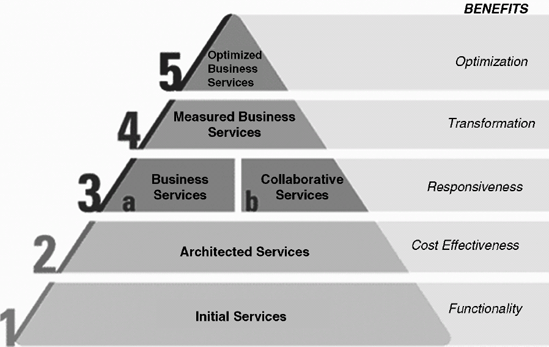8.5. SERVICE ORIENTED ARCHITECTURE MATURITY MODEL
[]A consortium of vendors led by Progress-Sonic Software has developed the SOA MM, which is explicitly based on CMMI. SOA MM aims to provide IT decision makers with "a simple framework for benchmarking the strategic value of their SOA implementation, and a model for visualizing future success."
Model Basics
Modeling itself after CMMI's maturity levels, SOA MM defines five levels of maturity with respect to SOA adoption. At each level, the model identifies progressive business benefits that the organization will be able to realize. As Exhibit 8.3 illustrates, the five maturity levels and key business impacts are:
Figure 8.3. Progress-Sonic's SOA MM defines five levels of maturity, modeled after the CMMI

- Level 1: Initial services (functionality). Deploy simple services as a part of research and development and/or pilot projects. Also de-fine initial ROI measurement criteria and define organizational needs for SOA.
- Level 2: Architected services (cost effectiveness). Design and implement an SOA infrastructure based on standards and planned reuse. Establish architectural leadership and identify SOA informational needs of the organization.
- Level 3: Business and collaborative services (responsiveness). Establish SOA governance, service life cycle policies, and cross-organizational partnerships. Move toward process-centric solutions and ...
Get Service Oriented Architecture Field Guide for Executives now with the O’Reilly learning platform.
O’Reilly members experience books, live events, courses curated by job role, and more from O’Reilly and nearly 200 top publishers.

